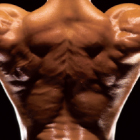 Q: I’m confused about the different muscles of the back. Would you briefly explain the back musculature?
Q: I’m confused about the different muscles of the back. Would you briefly explain the back musculature?
A: The back musculature has several sections and is very impressive on a lean physique when well developed. Because the lats and traps—especially the lats for many bodybuilders—are so visible in the mirror, they typically get similar attention in the gym to that given the pecs, delts and arms, which are other very visible muscles. Still, there’s a lot more to the back musculature than the lats and traps, as you can see from the accompanying photo.
At the bottom of the back is the start of the erector spinae, or erectors. Those are the thick columns of muscle on either side of the length of the spine—the iliocostalis, longissimus and spinalis groups—that stabilize the spine, extend it and move it from side to side. Some of the muscles produce rotation, too. Squats, deadlifts, back extensions and side bends train the erector spinae.
Either side of the erectors, just above your belt line and to the rear of your obliques, is the quadratus lumborum, which helps form the rear of your abdominal wall. When one side of the quadratus lumborum acts alone, it bends the spine to the side; when the two sides act together, they extend the spine. Exercises that train this muscle include side bends and back extensions.
The latissimus dorsi, or lat, is the large, winglike muscle that connects the humerus, or arm bone, to the lower vertebrae and pelvic girdle. The latissimus adducts, extends and medially rotates the humerus. Exercises that train the lats include machine pullovers, chinups and pullups, pulldowns and rows.
On and around the scapulae, the shoulder blades, are the rhomboids and the rotator cuff muscles. The rhomboideus major and minor, which connect some of the upper vertebrae to the scapula, retract and rotate them. Exercises that train the rhomboids include pulldowns and rows.
The rotator cuff is where the tendons of four small muscles in the upper back and shoulder area—the supraspinatus, infraspinatus, teres minor and subscapularis—fuse with the tissues of the shoulder joint. The rotator cuff muscles—the articular muscles of the shoulder—are involved in abduction, adduction and rotation of the humerus. The external rotators are usually neglected, which contributes to shoulder problems. By strengthening your external rotators you’ll increase the robustness of your shoulders. The external rotators are trained by the L-flye. Include it in your program.
To do the L-flye, lie on your left side on a bench, and place your left hand on the floor, for stability. With a small plate or very light dumbbell in your right hand, form a 90 degree angle at your elbow—an L shape. Put your right elbow on your right oblique muscles— or hip, depending on your body structure. A folded towel placed in the hollow between your hip and rib cage may help you to maintain the correct elbow position. Lower the weight until your right forearm rests against your abs, then raise your right forearm as far as possible. Keep your right elbow fixed against your side throughout the set. Inhale on the descent, and exhale on the ascent. Finish the set, turn around, and work your left side. Do the exercise slowly—three seconds for the lifting phase, a pause for a second at the top, a further three seconds for the lowering phase, a pause for a second at the bottom, and then smoothly move into the next ascent, and so on. Never train the L-flye to failure, never raise your elbow, and never roll backward even a little. Do the L-flye once a week, for one warmup set and one or two work sets per side.
The trapezius is the large, kite-shaped muscle that connects the skull, scapulae, clavicles and some upper vertebrae. It retracts, elevates, depresses and rotates the scapulae, and extends the head, moving it rearward. Exercises that train the traps include shrugs, rows and deadlift variations. The neck extension works the upper traps.
Very important: There are muscles beneath the visible layer of back muscles that I’ve just outlined. Those include small muscles between and around the vertebrae. Furthermore, there is the multifidii muscle group, beneath the erector spinae, from the sacrum, at the base of the spine, to the neck, which extends and rotates the vertebral column. Although you can’t see any of these muscles, by training them safely and making them much stronger, you can go a long way toward injuryproofing your back.
To train these hidden muscles, include the back extension, side bend and rotary torso in some of your programs. All it takes is a warmup set and one or two serious work sets for each exercise, once a week, and gradual progression in weight when you can manage it. Just that small amount of exercise can help a great deal to increase your resistance to back injury. Those three exercises also train other important muscles around your midsection—visible ones including your obliques, quadratus lumborum and erector spinae.
—Stuart McRobert
www.Hardgainer.com
Editor’s note: Stuart McRobert’s first byline in IRON MAN appeared in 1981. He’s the author of the new BRAWN series, Book 1: How to Build Up to 50 Pounds of Muscle the Natural Way, available from Home Gym Warehouse (800) 447-0008 or www.Home-Gym.com.




















You must be logged in to post a comment Login